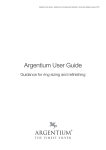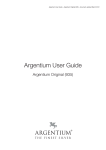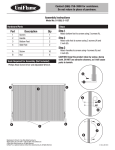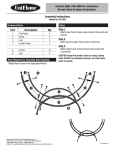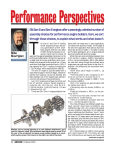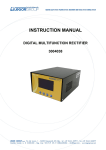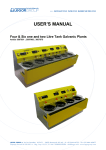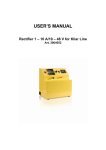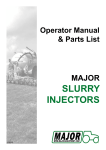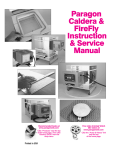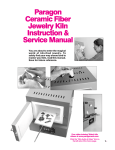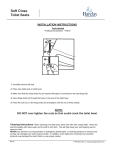Download Argentium User Guide
Transcript
Argentium User Guide - Argentium Professional Casting alloys - document updated March 2012 Argentium User Guide Argentium Professional Casting Alloys Argentium 935 Pro & Argentium 960 Pro Contents Alloy choice ........................................................ Page 2 Argentium 935 Pro Argentium 960 Pro Investment casting ............................................. Page 3 Flask burn-out Flask and metal temperatures Crucibles Accurate temperature control Protective gas cover Wet investment removal (suitable for castings without stones) Dry investment removal (suitable for stone-in-place castings) Heat-hardening treatment ................................... Page 4 Pickling ............................................................... Page 4 Finishing processes ............................................ Page 5-7 Optimising tarnish resistance Degreasing and rinsing Manual polishing Mechanical finishing Surface passivation Long term care ................................................... Page 8 ® Look for this sign for useful/important information to remember about Argentium silver. 1 Alloy choice Which Argentium Pro alloy is right for you? The Argentium Professional Casting alloys herald a new standard for investment casting applications - from small scale to high volume production. Easy to use, with superb qualities, these new alloys represent the most significant development in Argentium silver since its invention. Argentium 935 Pro • Containing 93.5% silver, this alloy exceeds the minimum silver requirement for a sterling grade alloy. • The alloy has been specifically developed to deliver consistent and reliable results for investment casting applications. • Argentium 935 Pro has an excellent as-cast surface quality with firestain resistance - this means that cast items can be easily finished to a beautiful lustre. • Tarnish resistance helps to maintain the bright-white colour of finished articles. • The alloy has excellent durability and is suitable for delicate and stone-in-place castings. Argentium 960 Pro • Containing 96% silver, this alloy surpasses the purity of the UK’s Britannia grade silver. • Argentium’s purest silver casting alloy is easy to use and designed for those who demand the very best. • This 960 grade alloy has excellent casting properties, including firestain resistance and a high quality as-cast surface that can be easily finished to a beautiful, bright-white lustre. • Finished items have an outstanding natural beauty and superior tarnish resistance. 2 Investment casting Flask burn-out • Allow the flask to stand for 2 hours before the burn-out cycle. • Do not overload the burn-out furnace - this ensures that the centre of all the flasks will reach the required temperature for complete burn-out and that there is sufficient air-flow to remove moisture from the cured investment powder. Flask and metal temperatures The following temperatures are for general guidance. Personal experience and knowledge of casting equipment will enable judgement of the suitable flask and casting temperatures to use. Argentium 935 Pro Size of object Thin: 0.2 - 0.5mm Medium: 0.5 - 1.2mm Thick: >1.2mm Metal casting temperature (thinner object = hotter temp.) 1040-1010°C / 1904-1850°F 1010-990°C / 1850-1814°F 990-970°C / 1814-1778°F Flask temperature (thinner object = hotter temp.) 600-560°C / 1112-1040°F 560-520°C / 1040-968°F 520-480°C / 968-896°F Metal casting temperature (thinner object = hotter temp.) 1055-1025°C / 1931-1877°F 1025-1005°C / 1877-1841°F 1005-985°C / 1841-1805°F Flask temperature (thinner object = hotter temp.) 620-580°C / 1148-1076°F 580-520°C / 1076-968°F 520-480°C / 968-896°F Argentium 960 Pro Size of object Thin: 0.2 - 0.5mm Medium: 0.5 - 1.2mm Thick: >1.2mm Crucibles • Use separate crucibles to avoid contamination from other alloys. • Clay graphite or pure graphite crucibles are recommended. • Silicon carbide crucibles are not recommended. Accurate temperature control • Argentium silver alloys display a paler colour glow than traditional sterling silver or Britannia silver when heated or molten. • Accurate temperature readings are important to prevent overheating. Protective gas cover • Use an inert gas cover (i.e. argon or nitrogen). • The cast flask should be held under the inert gas protection for 1 minute before removal from the casting chamber. Quenching and investment removal Wet investment removal (suitable for castings without stones) • After pouring the metal, remove from the casting chamber within 1 minute and leave flask to stand for at least 25 minutes before quenching in water. Dry investment removal (suitable for stone in place castings) • After pouring the metal, remove from the casting chamber within 1 minute and leave flask to cool for a minimum time of 90 minutes before quenching in water. • Remove investment residues by jet washing in water, followed by pickling, then rinse with water (do not rinse in deionised water - see ‘Important information’ page 5 ). 3 Heat-hardening treatments Argentium silver castings can be hardened by up to 2030HV (DPH) by performing a simple heat treatment. It is recommended that this heat treatment is carried out while the cast pieces are still attached to the investment cast tree and before any polishing operations take place. Simple heat treatment Heat Argentium silver in a furnace or oven in air at 300°C/572°F for 120 minutes, then air-cool to room temperature. Important information • Preheat the oven/furnace and supports to the required temperature before commencing the heathardening treatment. • Make sure that the oven/furnace is clean and free from chemicals and substances that may be detrimental to the heat treatment process. Pickling Recommended pickling solutions • Sodium bisulphate • Weak Sparex • Phosphoric acid • Sulphuric acid Do’s • Dilute pickle solution as advised by the supplier. • Heat pickle solution to recommended working temperature. • Use pickling solution that is not over-used. Don’ts • Do not use hydrofluoric acid with Argentium silver - hydrofluoric acid dissolves the protective germanium oxide and diminishes tarnish resistance. • Do not use old or over-used pickle as the strength of any pickling solution will reduce with use and saturated solutions can leave unwanted deposits on immersed items. Eternal Silver London Novell Studios / Kemp Metals 4 Finishing processes Optimising tarnish resistance Optimum tarnish resistance of Argentium silver relies upon applying good practice for finishing procedures. The aim of these finishing procedures is to optimise the formation of the protective germanium oxide that gives Argentium silver its tarnish resistance. Certain practices used in the trade with traditional sterling silver may harm Argentium’s protective germanium oxide and care must be taken not to contaminate the surface of Argentium silver with other metals/materials during polishing processes. The following recommendations are a guide to achieving a beautiful lustrous finish with optimum tarnish resistance. Degreasing and rinsing Argentium pieces should be ultrasonically cleaned, rinsed with tap water and thoroughly dried: 1) Between each polishing stage. 2) Before the final surface passivation heat/chemical treatment. Ultrasonic cleaning process recommended for commercial operations 1) Immerse pieces in an ultrasonic bath at 50°C (122°F) for 2 minutes using a 2% solution of the ‘Argentium approved’ cleaner supplied by Legor Group (legorgroup.com - product code 4580511). 2) Rinse with demineralised water at room temperature for 15 seconds. Ultrasonic cleaning process recommended for smaller scale operations 1) Immerse pieces in an ultrasonic bath at 40-60°C / 104-140°F for 2-3 minutes using a detergent solution (dishwashing detergents including Joy and Fairy are recommended). Ensure the pH of the cleaning solution is between 7-9. 2) Rinse with tap water and dry thoroughly. ® Important information Do not rinse Argentium silver alloys with deionised/reverse osmosis water - the high purity of this water can remove some of the protective germanium from the surface of Argentium, therefore reducing tarnish resistance. Steam cleaning and electrolytic cleaning should not be used with Argentium silver as these processes can diminish tarnish resistance. 5 Finishing processes Manual polishing ® Important information It is important to use separate polishing wheels, mops and compounds for Argentium silver to avoid contaminating the surface with residues from other metals or materials - surface contamination can diminish the tarnish resistance of Argentium items. If this is absolutely not possible, then polishing wheels and mops must be thoroughly cleaned/raked before use. The cutting (or dressing) stage requires the use of separate abrasive papers or wheels. Mechanical finishing (3 stage process) Stage 1 (optional) Surface burnishing operation - to brighten ‘hard to reach’ areas of items using magnetic pins in a nearneutral aqueous and soap solution (pH 7-9). Minimum time = 20 minutes. Stage 2 Cutting and dressing operation - the aim of this process is to smooth the surface and remove any ‘ascast’ surface layer. For mechanical polishing this involves the use of ceramic or plastic media in a nearneutral aqueous solution (pH 7-9) - use as recommended by the manufacturer. Stage 3 Polishing operation - to give a lustrous finish, use a dry polishing media such as crushed walnut shell (use as recommended by the manufacturer). Clean, rinse and dry items between each polishing stage (details given on page 5). Remember • Use separate polishing media for Argentium silver to prevent cross contamination with other metals/ materials. • Maintain clean polishing media and solutions. • Clean and rinse items between each polishing stage. • Thoroughly dry items after degreasing and rinsing. • Do not rinse with deionised/reverse osmosis water. David Worcester 6 Finishing processes Surface passivation - heat treatment Argentium silver’s tarnish resistance relies upon a protective germanium oxide surface layer. It is possible to assist the formation of this layer by applying a simple heat treatment to finished pieces. After pieces have received their final polishing and degreasing/cleaning operations, heat them in an oven in an air atmosphere at 100°C/212°F for 3-16 hours. No further polishing should be required provided that the oven is clean. If the pieces require any additional cleaning after this process, follow the cleaning instructions given on page 5. Important information • Ensure that the Argentium silver finished items are thoroughly clean before heat treating. • Preheat the oven to the required temperature before carrying out the heat treatment. • Make sure that the oven is clean and free from chemicals and substances that may be detrimental to the heat treatment process. Surface passivation - chemical treatment As an alternative to the heat passivation process it is possible to chemically treat Argentium silver, which allows the protective germanium oxide layer to develop naturally over a period of time underneath the protective layer. This treatment is particularly recommended instead of the heat passivation process where: • The manufacturing process does not allow the standard heat passivation process to be carried out. • The local atmosphere is known or suspected to contain significant amounts of sulphurous compounds (e.g. areas where there are higher levels of pollution). Treat the pieces with Legor Group’s Tenaris Pro (legorgroup.com) in accordance with the manufacturer’s instructions. This chemical passivation will protect the pieces from discoloration until a protective germanium oxide layer has naturally developed. Taché Jewelry 7 Long term care Argentium silver is low maintenance, easy to care for and simple to keep clean. Simply wipe away any dust or finger marks with a soft cloth or, for more intricate pieces, wash them in warm soapy water, rinse and dry immediately to avoid water marks. An occasional wipe with a clean silver polishing cloth will help to maintain Argentium silver’s beautiful shine and lustre (Goddard’s Long Term Silver Cloths and Tiffany & Co. Cloths are recommended). Avoid using coarse, contaminated or old cloths as they may impair the surface lustre of Argentium silver. Please do not use ‘dip’ polishes or electrolytic cleaning processes with Argentium silver. ® Important care advice As recommended for other precious metals, it is advisable to remove Argentium silver jewellery before entering chlorinated or salt-water swimming baths/jacuzzis and before carrying out activities where Argentium could come into contact with chemicals. Celegato Silver Jewels 8 For sales and technical enquiries please email [email protected] or visit our website argentiumsilver.com ARGENTIUM® and ® are registered trademarks of Argentium International Limited.










